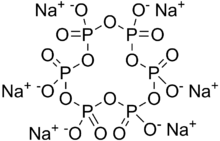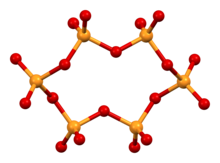Chemistry:Sodium hexametaphosphate

| |

| |

| |
| Names | |
|---|---|
| IUPAC name
sodium cyclo-hexaphosphate
| |
| Other names
Calgon S
Glassy sodium | |
| Identifiers | |
3D model (JSmol)
|
|
| ChemSpider | |
| EC Number |
|
| MeSH | sodium+polymetaphosphate |
PubChem CID
|
|
| UNII | |
| |
| |
| Properties | |
| Na 6[(PO 3) 6] | |
| Molar mass | 611.7704 g mol−1 |
| Appearance | White crystals |
| Odor | odorless |
| Density | 2.484 g/cm3 |
| Melting point | 628 °C (1,162 °F; 901 K) |
| Boiling point | 1,500 °C (2,730 °F; 1,770 K) |
| soluble | |
| Solubility | insoluble in organic solvents |
Refractive index (nD)
|
1.482 |
| Hazards | |
| Main hazards | Irritant |
| Safety data sheet | hazard.com |
| GHS pictograms | 
|
| GHS Signal word | Warning |
| H319 | |
| Lethal dose or concentration (LD, LC): | |
LD50 (median dose)
|
3.053 g kg−1 |
| Related compounds | |
Other anions
|
Trisodium phosphate Tetrasodium pyrophosphate Pentasodium triphosphate |
Related compounds
|
Sodium trimetaphosphate |
Except where otherwise noted, data are given for materials in their standard state (at 25 °C [77 °F], 100 kPa). | |
| Infobox references | |
Sodium hexametaphosphate (SHMP) is a salt of composition Na
6[(PO
3)
6].[3] Sodium hexametaphosphate of commerce is typically a mixture of metaphosphates (empirical formula: NaPO3), of which the hexamer is one, and is usually the compound referred to by this name. Such a mixture is more correctly termed sodium polymetaphosphate. They are white solids that dissolve in water.
Uses
SHMP is used as a sequestrant and has applications within a wide variety of industries, including as a food additive in which it is used under the E number E452i. Sodium carbonate is sometimes added to SHMP to raise the pH to 8.0–8.6, which produces a number of SHMP products used for water softening and detergents.
A significant use for sodium hexametaphosphate is as a deflocculant in the production of clay-based ceramic particles.[4][5][6][7] It is also used as a dispersing agent to break down clay and other soil types for soil texture assessment.[8]
It is used as an active ingredient in toothpastes as an anti-staining and tartar prevention ingredient.[9]
Food additive
As a food additive, SHMP is used as an emulsifier. Artificial maple syrup, canned milk, cheese powders and dips, imitation cheese, whipped topping, packaged egg whites, roast beef, fish fillets, fruit jelly, frozen desserts, salad dressing, herring, breakfast cereal, ice cream, beer, and bottled drinks, among other foods, can contain SHMP.[10][11][12]
Water softener salt
SHMP is used in Diamond Crystal brand Bright & Soft Salt Pellets for water softeners in a concentration of 0.03%. It is the only additive other than sodium chloride.
Preparation
SHMP is prepared by heating monosodium orthophosphate to generate sodium acid pyrophosphate:
- 2 NaH2PO4 → Na2H2P2O7 + H2O
Subsequently, the pyrophosphate is heated to give the corresponding sodium hexametaphosphate:
- 3 Na2H2P2O7 → (NaPO3)6 + 3 H2O
followed by rapid cooling.
Reactions
SHMP hydrolyzes in aqueous solution, particularly under acidic conditions, to sodium trimetaphosphate and sodium orthophosphate.[13]
History
Hexametaphosphoric acid was named in 1849 by the German chemist Theodor Fleitmann.[14][15] By 1956, chromatographic analysis of hydrolysates of Graham's salt (sodium polyphosphate) indicated the presence of cyclic anions containing more than four phosphate groups;[16] these findings were confirmed in 1961.[17] In 1963, the German chemists Erich Thilo and Ulrich Schülke succeeded in preparing sodium hexametaphosphate by heating anhydrous sodium trimetaphosphate.[18]
Safety
Sodium phosphates are recognized to have low acute oral toxicity. SHMP concentrations not exceeding 10,000mg/L or mg/kg are considered protective levels by the EFSA and USFDA. Extreme concentrations of this salt may cause acute side effects from excessive blood serum concentrations of sodium, such as: “irregular pulse, bradycardia, and hypocalcemia."[19]
References
- ↑ Merck Index, 12th Edition, Sodium polymetaphosphate, 8814
- ↑ "C&L Inventory". https://echa.europa.eu/information-on-chemicals/cl-inventory-database/-/discli/details/3602.
- ↑ Greenwood, Norman N.; Earnshaw, Alan (1997). Chemistry of the Elements (2nd ed.). Butterworth-Heinemann. p. 530. ISBN 978-0-08-037941-8.
- ↑ The Role Of Sodium Hexametaphosphate In The Dissolution Process Of Kaolinite And KaolinF. Andreola; E.Castellini; T.Manfredini; M.Romagnoli. Journal of the European Ceramic Society, Volume 24, Number 7, June 2004.
- ↑ Impact Of Dispersants On The Mechanical Strength Development Of Alumina-Spinel Self-Flowing Refractory Castables. Sasan Otroj, Mohammad Reza Nilforushan, Arash Daghighi, Reza Marzban. Ceramics – Silikáty 54 (3) 284–289 (2010)
- ↑ Effect Of Adding Sodium Hexametaphosphate Liquefier On Basic Properties Of Calcium Phosphate Cements. S. Hesaraki; A. Zamanian; F. Moztarzadeh. Journal of Biomedical Materials Research Part A. Vol. 88A, No. 2, 2009
- ↑ Study Of Clay’s Mineralogy Effect On Rheological Behavior Of Ceramic Suspensions Using An Experimental Design. Afef Jmal Ayadi; Julien Soro; Amel Kamoun; Samir Baklouti. International Journal of Recent Research and Applied Studies 14 (2). February 2013.
- ↑ ASTM D422 – 63(2007) Standard Test Method for Particle-Size Analysis of Soils.
- ↑ "Crest Pro-Health Frequently Asked Questions". http://www.crestprohealth.com/pro-health-faq/.
- ↑ "Ingredient Results - Sodium Hexametaphosphate". http://www.befoodsmart.com/ingredients/sodium-hexametaphosphate.php.
- ↑ "Food Additives & Ingredients - Food Additive Status List". 26 August 2021. https://www.fda.gov/food/ingredientspackaginglabeling/foodadditivesingredients/ucm091048.htm.
- ↑ "CFR - Code of Federal Regulations Title 21". http://www.accessdata.fda.gov/scripts/cdrh/cfdocs/cfcfr/cfrsearch.cfm?fr=173.310.
- ↑ Van Wazer, John (1958). Phosphorus and its Compounds. New York: Interscience Publishers. http://catalog.hathitrust.org/Record/010058734. Retrieved 7 April 2015.
- ↑ Fleitmann, Th. (1849). "Ueber die verschiedenen Metaphosphorsäuren und zwei neue Säuren derselben Verbindungsproportion" (in de). Annalen der Physik und Chemie. 2nd series 78: 233–260, 338–366. https://babel.hathitrust.org/cgi/pt?id=umn.31951d00321228n;view=1up;seq=251. On p. 249, Fleitmann coined the name Hexametaphosphorsäure (hexametaphosphoric acid).
- ↑ Griffith, E.J.; Buxton, R.L. (1965). "The preparation and properties of the twelve-membered ring hexametaphosphate anion". Inorganic Chemistry 4 (4): 549–551. doi:10.1021/ic50026a023. ; see p. 549.
- ↑ Van Wazer, J. R.; Kroupa, E. Karl (1956). "Existence of ring phosphates higher than tetrametaphosphate". Journal of the American Chemical Society 78 (8): 1772. doi:10.1021/ja01589a086.
- ↑ (Thilo & Schülke, 1963a), p. 1175.
- ↑ See:
- Thilo, E.; Schülke, U. (1963a). "Darstellung des echten Natrium-hexametaphosphates Na6[P6O18]" (in de). Angewandte Chemie 75 (23): 1175–1176. doi:10.1002/ange.19630752305. Bibcode: 1963AngCh..75.1175T.
- Thilo, E.; Schülke, U. (1963b). "Preparation of true sodium hexametaphosphate Na6[P6O18]". Angewandte Chemie International Edition 2 (12): 742. doi:10.1002/anie.196307421.
- ↑ Schrödter, Klaus; Bettermann, Gerhard; Staffel, Thomas; Wahl, Friedrich; Klein, Thomas; Hofmann, Thomas (2008). "Ullmann's Encyclopedia of Industrial Chemistry". Ullmann's Encyclopedia of Industrial Chemistry. Weinheim: Wiley-VCH. doi:10.1002/14356007.a19_465.pub3.
External links
 |

